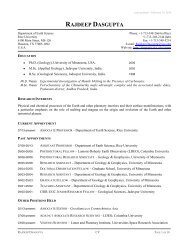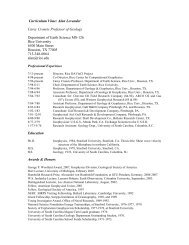Introduction to Borehole Observatories in ODP/IODP
Introduction to Borehole Observatories in ODP/IODP
Introduction to Borehole Observatories in ODP/IODP
- No tags were found...
Create successful ePaper yourself
Turn your PDF publications into a flip-book with our unique Google optimized e-Paper software.
Early <strong>ODP</strong>Observa<strong>to</strong>ry EffortsDat<strong>in</strong>g back <strong>to</strong> 1980‘s, there were twoma<strong>in</strong> orig<strong>in</strong>al <strong>ODP</strong> observa<strong>to</strong>ry efforts <strong>in</strong>parallel:OSN/ION broadband seismicobserva<strong>to</strong>riesCORK hydrogeological observa<strong>to</strong>riesS<strong>in</strong>ce the start of I<strong>ODP</strong>, the purely OSNeffort has stalled, but a variety of CORKand related borehole observa<strong>to</strong>ries haveflourished. I<strong>ODP</strong> borehole observa<strong>to</strong>rydesigns now span a range of geophysical,geochemical, and microbiologicalobjectives.JR,19861994
CORK and OSN/ION Holes, 1991-2004
<strong>ODP</strong> CORK and OSN/ION Holes, 1991-2004OSN sites not (yet?)permanently <strong>in</strong>strumented
Two Primary CORK and Drill<strong>in</strong>g Focus Regimes <strong>to</strong>Date:1. Ocean crust with thermally-driven fluid flow2. Subduction systems with compaction-driven flowJOIDES Hydrogeology PPG Report (2001)<strong>ODP</strong>/I<strong>ODP</strong> have also made pioneer<strong>in</strong>g efforts <strong>to</strong> understand fluid flow <strong>in</strong>carbonate, gas hydrate, and overpressured passive marg<strong>in</strong> sett<strong>in</strong>gs.
Motivation: Hydrological Disruption via Open Reentry HolesBefore CORKs, open reentry holes often resulted <strong>in</strong> <strong>in</strong>advertent flowperturbation experiments that yielded estimates of flow rates andpermeabilities but disrupted <strong>in</strong>-situ hydrogeological state and fluids.CORKs seal holes <strong>to</strong> s<strong>to</strong>p flow + control perturbation -hence the acronym “Circulation Obviation Retrofit Kit”
Initial CORK ConceptThe 1989 d<strong>in</strong>ner-napk<strong>in</strong>sketch by Earl Davis,Bobb Carson,Keir BeckerOrig<strong>in</strong>al name:Instrumented <strong>Borehole</strong>SealRenamed CORK <strong>in</strong>1991, for “CirculationObviation Retrofit Kit”
Orig<strong>in</strong>al <strong>ODP</strong> CORK Hydrogeological Observa<strong>to</strong>ryMotivation: Seal reentry holes <strong>to</strong>prevent hydrological perturbation andallow reestablishment of <strong>in</strong>-situconditions, with capabilities for:• Long-term moni<strong>to</strong>r<strong>in</strong>g of T & P for• Background <strong>in</strong>-situ values• Hydrologic transients• Subsurface tidal load<strong>in</strong>g effects• Transients of tec<strong>to</strong>nic orig<strong>in</strong>•••Sampl<strong>in</strong>g of formation fluidsActive hydrologic formation test<strong>in</strong>gRecently, microbiological expts14 Orig<strong>in</strong>al CORKs <strong>in</strong>stalled 1991-2001 <strong>in</strong> sedimented young oceaniccrust (shown) and subductionsett<strong>in</strong>gs.
Limitations of Orig<strong>in</strong>al Design Multi-Zone ModelsWith only one seal at seafloor, signalsfrom entire open-hole or perforatedsection are averaged.For many cases, isolat<strong>in</strong>g multiplezones <strong>in</strong> a s<strong>in</strong>gle hole would yieldmuch more representative results.Start<strong>in</strong>g <strong>in</strong> 1999, three multi-zoneCORK models have been developed,all utiliz<strong>in</strong>g downhole packers:• “Advanced CORK” or ACORK• “Wirel<strong>in</strong>e CORK”• “CORK-II”14 multi-zone CORKs <strong>in</strong>stalled 2001 -2011 <strong>in</strong> sedimented young ocean crustand subduction sett<strong>in</strong>gs.Advanced CORK Workshop (1998)
Evolution of CORK Designs, 1991-2011From s<strong>in</strong>gle-seal orig<strong>in</strong>al CORK <strong>to</strong> multi-seal ACORK and CORK-II<strong>to</strong> downhole s<strong>in</strong>gle-seal memory “Smart Plug” and “Genius Plug”...Orig<strong>in</strong>al CORKAdvanced CORKData loggerCORK IIData loggerSampl<strong>in</strong>gportsSampl<strong>in</strong>gportsData loggerSmart PlugRe-entryconeRe-entryconeSea floorSea floorSea floorSea floorSeal16" cas<strong>in</strong>g Seal16" cas<strong>in</strong>g Seal16" cas<strong>in</strong>gSealStandard 10 3/4"cas<strong>in</strong>gHydraulicconduits10 3/4" cas<strong>in</strong>g Standard10 3/4" cas<strong>in</strong>gThermis<strong>to</strong>rcableGroutMultiple<strong>to</strong>ol str<strong>in</strong>gReamedLWD holePackerPackerPackerZone Ahydraulicsampl<strong>in</strong>gportZone Bhydraulicsampl<strong>in</strong>gportZone Chydraulicsampl<strong>in</strong>gportZone AZone BZoneCReamedLWD holeMultiple<strong>to</strong>ol str<strong>in</strong>gPackerPacker4 Ω” l<strong>in</strong>erZone AZone BRecoverablebridge plugMoni<strong>to</strong>r<strong>in</strong>g<strong>in</strong>strumentStandard 10 3/4"cas<strong>in</strong>gGroutFluidsamplerUncased9 7/8"RCB holeUncased9 7/8"RCB holeSeismometer andstra<strong>in</strong> gaugeUncased9 7/8"RCB holeGrout
Componentsfor multi-levelpressuremoni<strong>to</strong>r<strong>in</strong>gand fluidsampl<strong>in</strong>gAt wellhead:absolute pressure sensors,PPB digitizers, T sensors,power, data s<strong>to</strong>rage,and pressure l<strong>in</strong>e control valvesOutside sealed cas<strong>in</strong>g:permeable filterscreensPressure transmissionfrom screens <strong>to</strong> seafloorvia hydraulic tub<strong>in</strong>g12
CORK components deployed <strong>in</strong>side or below cas<strong>in</strong>gWellheadconnections:electrical, pressure,flow, and <strong>in</strong>side-cas<strong>in</strong>gaccessSeismometer, tilt meter<strong>in</strong> or below cas<strong>in</strong>gThermis<strong>to</strong>rs<strong>in</strong>side, outside,or below cas<strong>in</strong>gStra<strong>in</strong>meterbelow cas<strong>in</strong>g13
Fluid Sampl<strong>in</strong>g via CORKs (I)Orig<strong>in</strong>al CORK design <strong>in</strong>corporated1/2” teflon tub<strong>in</strong>g runn<strong>in</strong>g fromformation <strong>to</strong> valves on the wellhead,but this did not work well.Major improvement: development ofself-conta<strong>in</strong>ed OsmoSamplers <strong>in</strong>stalledon the sensor str<strong>in</strong>g and recoveredyears later.Latest multi-zone “CORK-II” and“CORK-Lite” designs <strong>in</strong>corporatecapability <strong>to</strong> deploy OsmoSamplers forfluid geochemical and microbiologicalobjectives both deep <strong>in</strong> sealed holesand at wellhead valves with access <strong>to</strong><strong>in</strong>-situ fluids via small-diameter tub<strong>in</strong>g.
Fluid Sampl<strong>in</strong>g via CORKs (II)When the formation is overpressured and transmissive, as at somesediment-buried basement highs <strong>in</strong> young crust, then sampl<strong>in</strong>g viathe CORK valve is promis<strong>in</strong>g.Pro<strong>to</strong>typeCowen/Johsonmicrobiologicalsampler at Hole1026B. SeeCowen et al,Nature (2003)for results.
CORK-II System as onI<strong>ODP</strong> Exps. 327, 336 -Current “Standard” Modelfor Basement Holes•Four nested cas<strong>in</strong>g str<strong>in</strong>gs, withmultiple seal<strong>in</strong>g systemsMultiple moni<strong>to</strong>r<strong>in</strong>g levels with<strong>in</strong>flatable + swellable packersTub<strong>in</strong>g umbilical from formation <strong>to</strong>seafloor, br<strong>in</strong>g<strong>in</strong>g pressure and fluids<strong>to</strong> wellhead gauges and samplersFree-flow valve for produc<strong>in</strong>g holeMultiple sensors/samplerssuspended <strong>in</strong> hole:••••••Memory temperature loggersFluid/gas “OsmoSamplers”Microbiological experiments•
2011 ROV Fly-Around, Hole 1362A CORK-IICourtesy A. Fisher, S.Video Courtesy Andy Fisher
CORKs: Submersible Support from National Fund<strong>in</strong>gAgencies (e.g., NSF, JAMSTEC,…)CORKs require submersible servic<strong>in</strong>gon ~2-3 yr <strong>in</strong>tervals (data download,battery or <strong>in</strong>strument exchanges).• Alv<strong>in</strong>: 1991, 1993-1995, 1997-2002,2004-2009• Jason/Jason II: 1998, 2003, 2010-2012• MPL Control Vehicle: 1999, 2001• ROPOS: 1992, 2004, 2010, 2011• Nautile: 1995, 1998• Kaiko-10k: 2002, 2003• Kaiko-7k: 2006-2009, 2011, 2012• HyperDoph<strong>in</strong>, 2009• Sh<strong>in</strong>kai 6500: 2004
•••CORK Fund<strong>in</strong>g Model(s)Red/orange = CORK‘<strong>in</strong>frastructure’ traditionally fundedby <strong>ODP</strong>/I<strong>ODP</strong>.Blue = Scientific <strong>in</strong>strumentationnormally funded by nationalagencies (e.g., NSF, GSC, IFREMER,JAMSTEC) based on regularresearch proposals.Submersible servic<strong>in</strong>g operationsalso require fund<strong>in</strong>g from agenciesbased on research proposals.•Fund<strong>in</strong>g model was extended by
New Observa<strong>to</strong>ry Concepts for Future -“Earth <strong>in</strong> Motion” Theme of New Science Plan• NanTroSEIZE Smart Plug and Riser-Hole Moni<strong>to</strong>r<strong>in</strong>g System (right)• “Seis-CORK” with seismometers• Simpler pressure-only “S-CORK” asproxy for crustal stra<strong>in</strong>• SCIMPI (Simple Cabled Instrument<strong>to</strong> Measure Parameters In-situ) forupper sediments (~200-300m)• L<strong>in</strong>k<strong>in</strong>g <strong>to</strong> shore with seafloor cables- several CORKs connected orscheduled <strong>to</strong> connect <strong>to</strong> NeptuneCanada cable <strong>in</strong> 2009-2012• CORK-Lite for legacy reentry holes• Observa<strong>to</strong>ries deployed withseafloor drill systems (BGS, MEBO...)NanTroSEIZE Phase 3 20underway <strong>in</strong> Japan for a seafloor fiber-optic cable network <strong>in</strong> the Kumano region for geodetic(A-GPS) and seismic moni<strong>to</strong>r<strong>in</strong>g; we are coord<strong>in</strong>at<strong>in</strong>g efforts with that group so that, if it isconstructed, the borehole will be tied <strong>in</strong> for real-time data transmission. Otherwise, periodic datadownload from the wellhead through ROVs/submersibles or telemetry will be required. In anycase, the seafloor network if built will provide much of the broader distributed geophysicalcontext for address<strong>in</strong>g our goals, outside of I<strong>ODP</strong> efforts.SeismometryFigure 9. Conceptual drill<strong>in</strong>g and<strong>in</strong>strumentation plan proposed forNT3-01A. Drill<strong>in</strong>g would proceedwith a mix of LWD and cor<strong>in</strong>g withcas<strong>in</strong>g <strong>to</strong> <strong>to</strong>tal depth, followed bysidetrack<strong>in</strong>g <strong>to</strong> core the prime faulttargets and <strong>in</strong>stall moni<strong>to</strong>r<strong>in</strong>g<strong>in</strong>strumentation. Sensors shown arepositioned schematically. A numberof sensor elements are not shownfor clarity, <strong>in</strong>clud<strong>in</strong>g fiber opticthermis<strong>to</strong>r arrays and fluidpressure l<strong>in</strong>es. Packers isolateperforated zones for fluidcommunication <strong>to</strong> the formationabove, below, and <strong>in</strong>side each of the2 target fault zones. Depths arebased on L<strong>in</strong>e 5 <strong>in</strong> figure 2, butborehole deviation is not <strong>to</strong> scale.Seismological data will be collected dur<strong>in</strong>g both the drill<strong>in</strong>g and moni<strong>to</strong>r<strong>in</strong>g stages of thePhase 3 project. These experiments will <strong>in</strong>clude Vertical Seismic Profiles (VSPs), a vertical
Wirel<strong>in</strong>e CORK + CORK-LiteWirel<strong>in</strong>e CORK (right) <strong>in</strong>stalled withMPL Control Vehicle <strong>in</strong> Hole 504B(Becker et al, EPSL, 2004).CORK-Lite (below) <strong>in</strong>stalled 2012 withROV Jason <strong>in</strong> Hole 1383B (Wheat etal, S.D. <strong>in</strong> press).504BCORK-Lite1383B!
An opportunistic approach:Strapped-on screens and hydraulic l<strong>in</strong>es22
<strong>Borehole</strong> Observa<strong>to</strong>ries Connected <strong>to</strong> Shore by CablesJuan de Fuca Hole 1026BCORK <strong>in</strong>stalled 1996CORK-II <strong>in</strong>stalled 2004NEPTUNE-connected 2009Next:Nankai C0002 (Donet)Cascadia 1364A and JFR1027, 1362 (NEPTUNE)23





